I wasn’t sure what to expect when I booked this trip. Azerbaijan. Most people I told gave me that blank stare – you know the one. “Where’s that exactly?” Somewhere between Europe and Asia, I’d explain. Where the Caspian Sea meets mountains that look like they’re from another planet.
The flight path took me over Istanbul, then east. I spent most of it staring out the window like a kid.
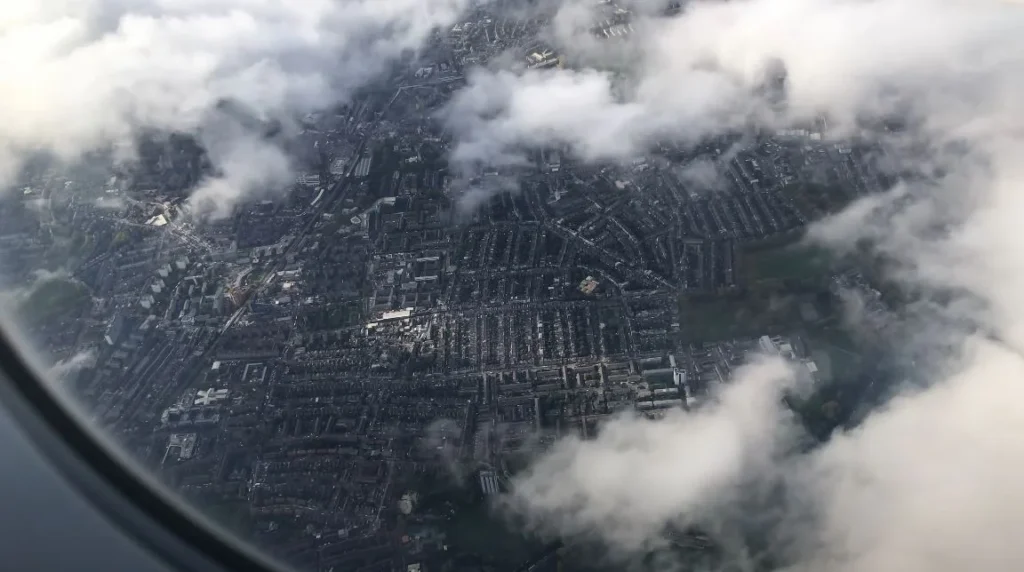
Coming in through the clouds, Baku sprawled below – this strange mix of ancient stone and glass towers that caught the morning light. The Caspian stretched out grey-blue to the horizon. The plane dropped lower and I could make out the geometric patterns of Soviet-era housing blocks giving way to older neighborhoods with terracotta roofs clustered tight.
Heydar Aliyev International Airport was surprisingly modern. Sleek. The immigration officer barely looked at my passport before stamping it. Welcome to Azerbaijan.
Baku’s Autumn Canvas
First Impressions: A City of Contrasts
The taxi into the city center – actually, let me be honest, it was more like controlled chaos on wheels – gave me my first real taste of Baku. Our driver wove through traffic like he was playing a video game. No seatbelt clicks, no hesitation. Just pure confidence and a lot of horn.
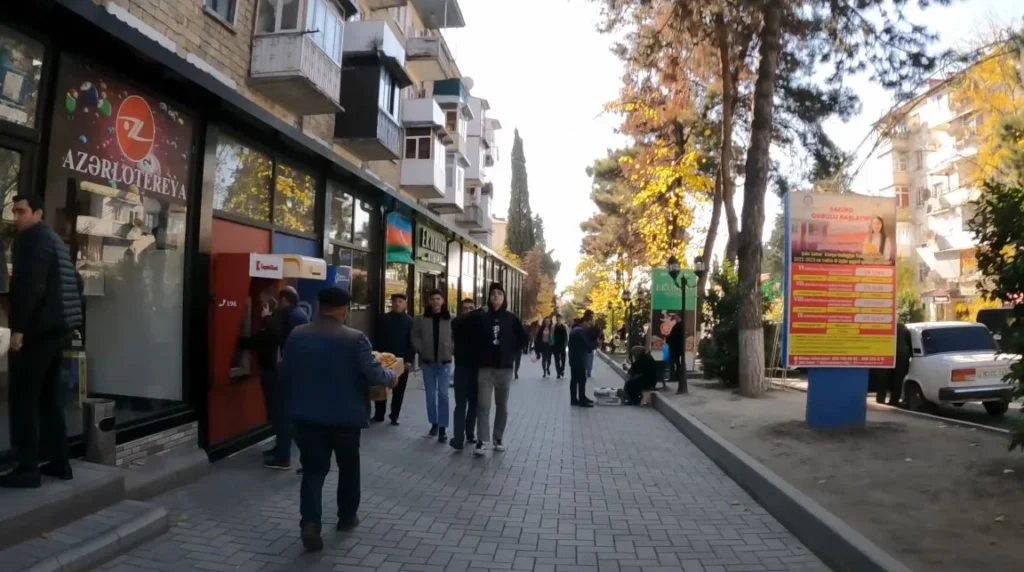
But what got me was the color. October had turned everything golden. The city’s tree-lined boulevards were exploding in yellow and amber. I’d read somewhere that autumn in Baku was beautiful, but nobody told me it would look like the trees were literally on fire.
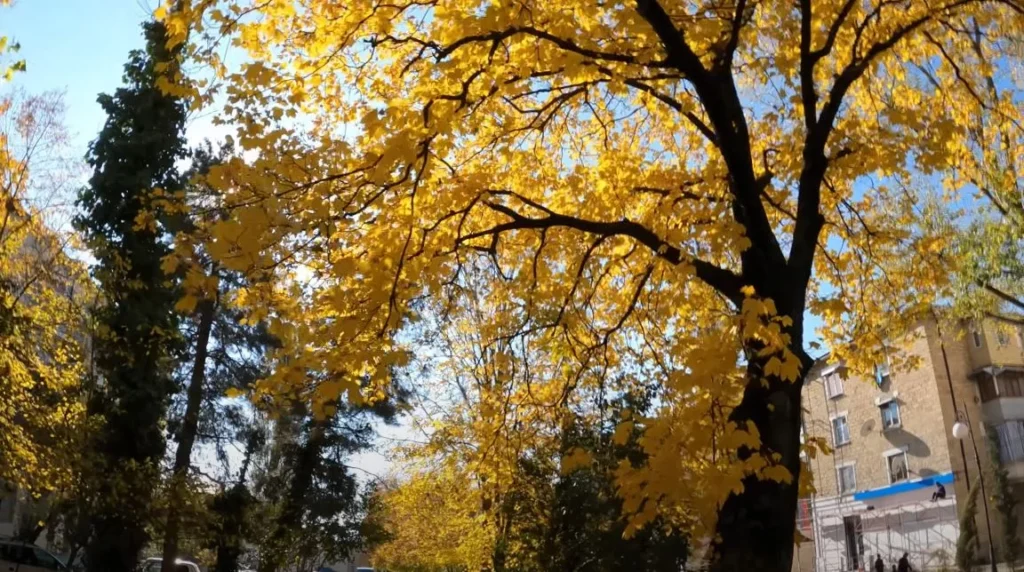
Checked into Hotel Qrand around midday.
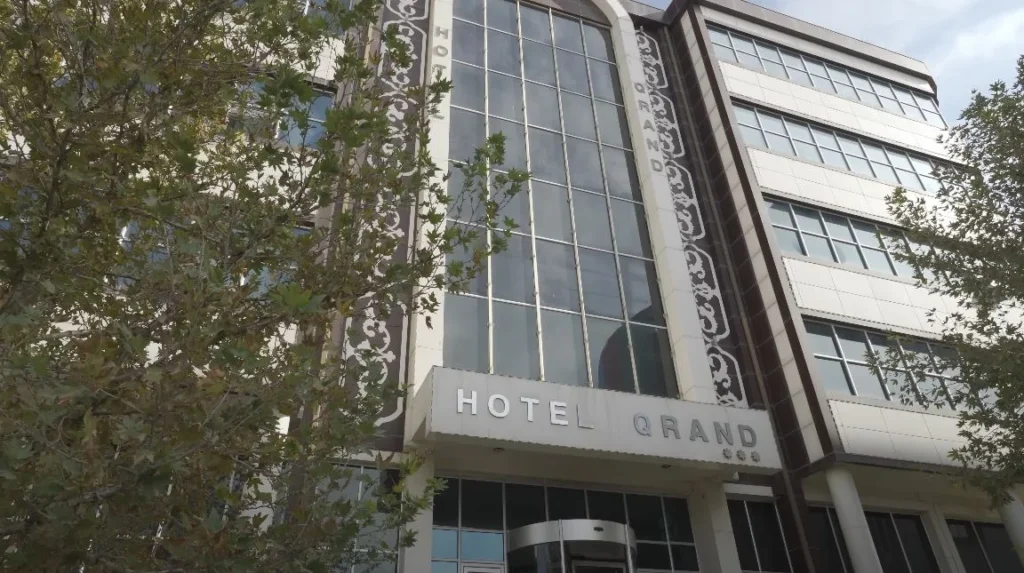
Nothing fancy, but clean, central and the woman at reception spoke enough English to point me toward the good food. “Go to Fountain Square,” she said. “Walk everywhere from there.”
So I did.
Wandering Through Layers of Time
Fountain Square became my anchor point. From there, the Old City – Icherisheher – was a ten-minute walk downhill. But before I got to the ancient stuff, I kept getting sidetracked by these perfectly preserved 19th-century buildings. Russian Imperial architecture mixed with something distinctly Azerbaijani. Ornate balconies, carved wooden shutters, that specific kind of decay that somehow looks intentional.
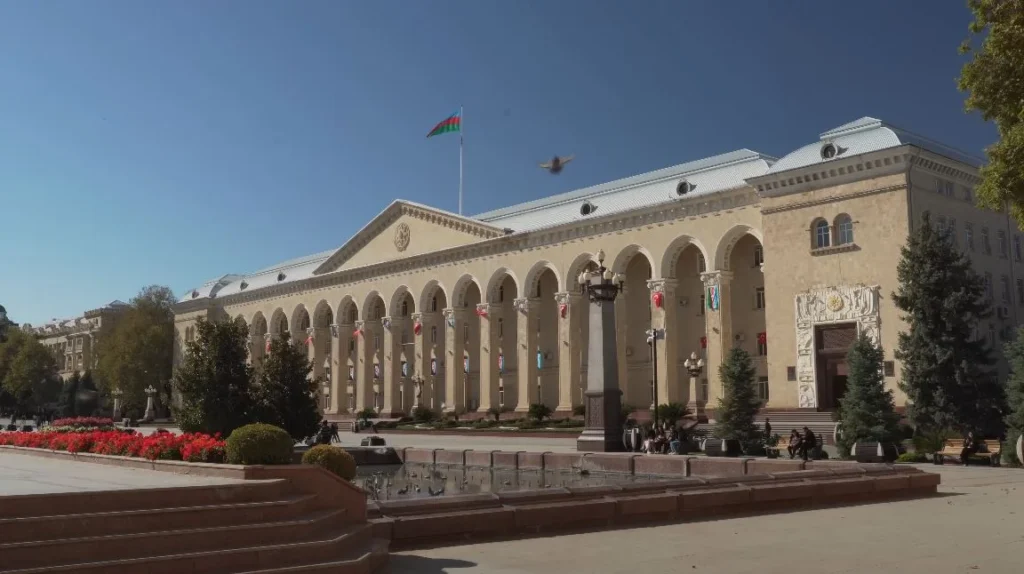
The government buildings were massive. Columns everywhere. The kind of architecture designed to make you feel small and the state feel eternal. But then you’d turn a corner and find a tiny courtyard where old men played backgammon under grape vines.
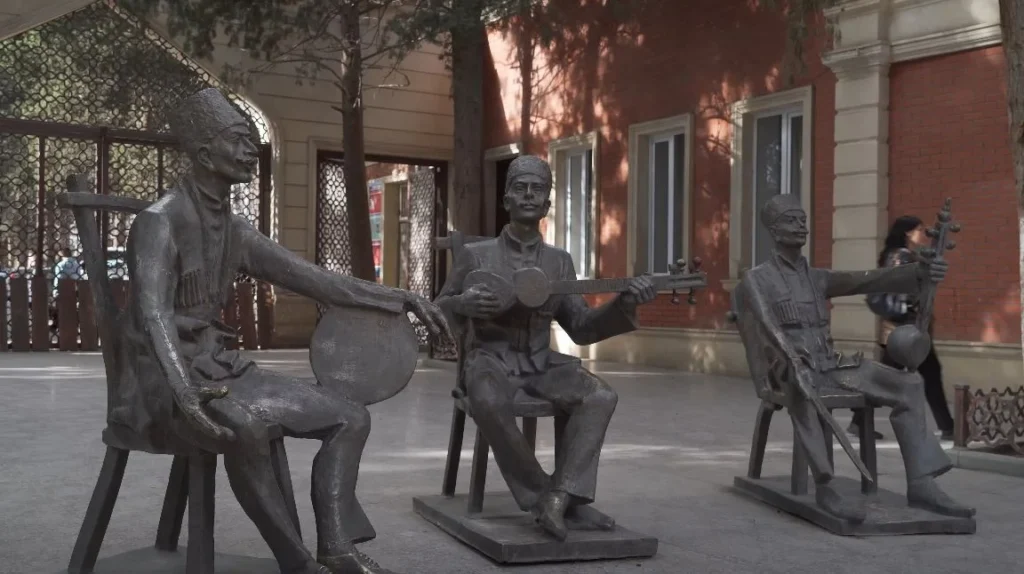
Found this sculpture tucked away near one of the pedestrian streets – three musicians frozen mid-performance. Bronze guys with a tar, a kamancha and what looked like a dombra. I sat there for twenty minutes just watching people interact with it. Kids climbing on the chairs. A couple taking selfies. An old woman who touched the tar player’s shoulder like she was greeting an old friend.
That’s when it hit me: Baku doesn’t show off it’s culture. It just lives it.
Soviet Ghosts and Modern Hustle
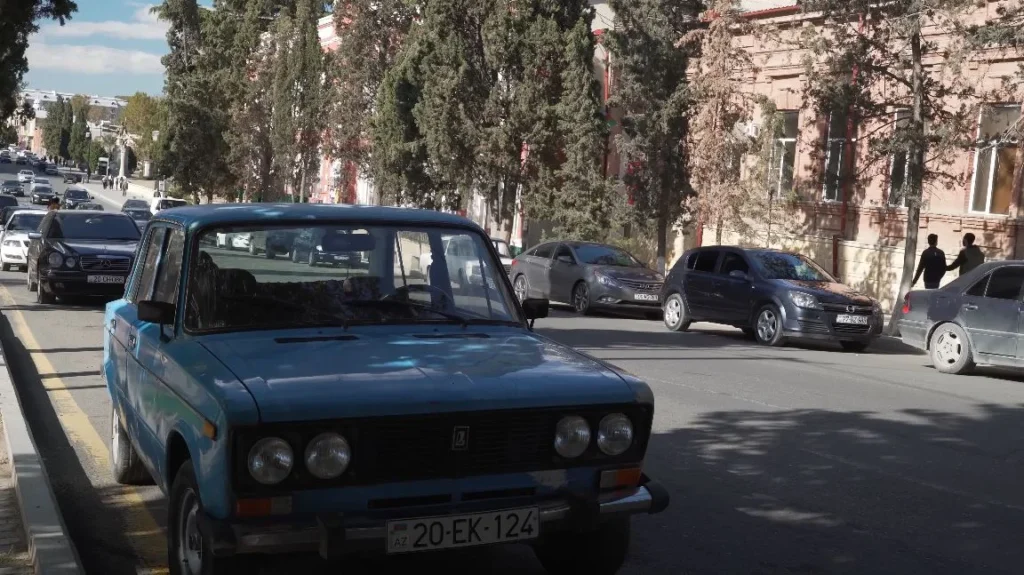
The streets were full of these old Soviet Ladas. Not parked in museums – actually driving, actually being used. This turquoise one I photographed had a license plate from 1999 and was parked like it owned the place. The contrast between these rust-bucket relics and the new BMWs cruising past was almost comical.
The public transport was it’s own adventure. I took a bus once.
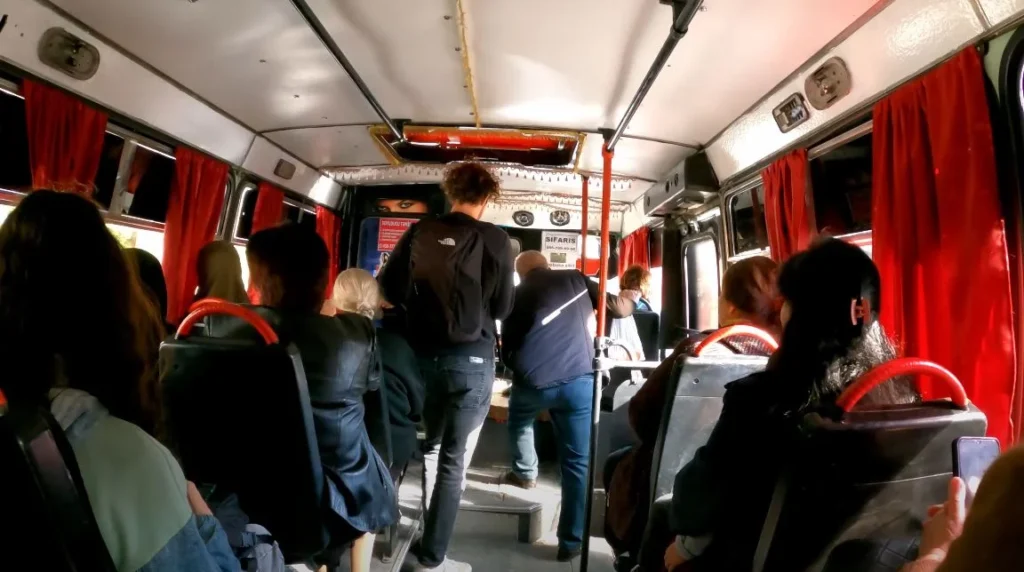
Red velvet curtains inside. Not kidding. The whole interior looked like someone’s grandmother had decorated it. People squeezed in until physics said no more, then two more people got on. The driver’s collection of religious icons and family photos was taped above the windshield, vibrating with every pothole.
I loved it.
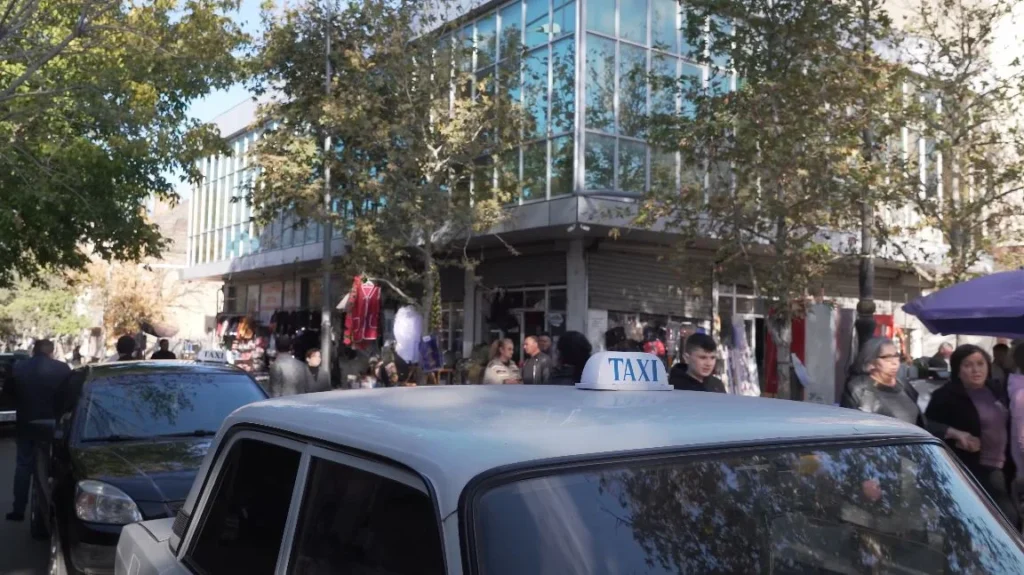
The taxis – marked with that simple “TAXI” sign on the roof – were everywhere. No meters, really. Just negotiation. I learned to say numbers in Azerbaijani real quick. “Iki manat?” Two manats? The drivers would laugh, counter with something higher and we’d settle somewhere in the middle.
Street vendors set up every morning near the metro stations.
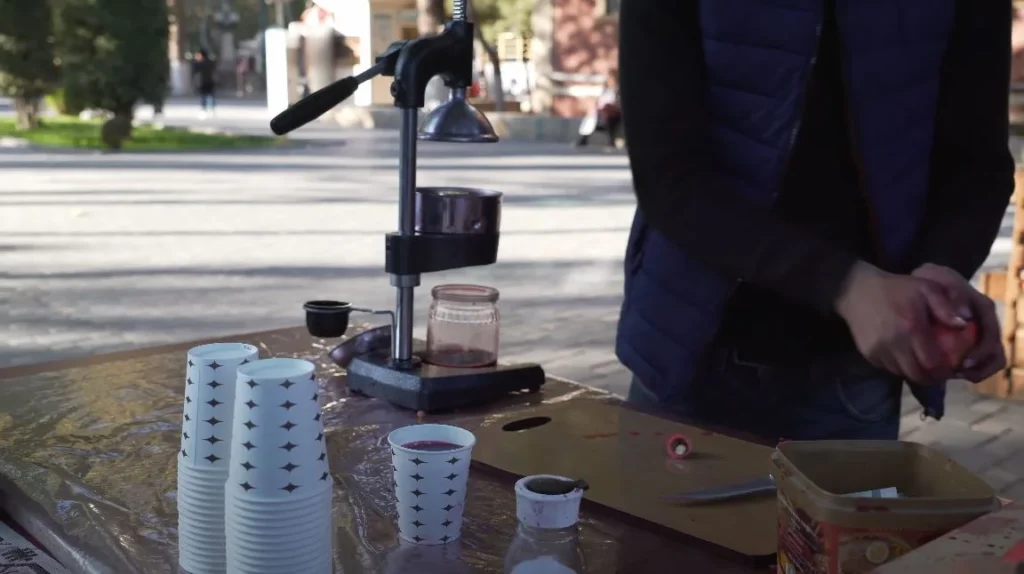
This guy was making tea the traditional way – that same setup you see across the Caucasus. The old-school press, those small glass cups, sugar cubes on the side. I stopped for tea three mornings in a row and I’m pretty sure he started recognizing me by the second day. We never exchanged more than “salam” and “sagol,” but there was this understanding. I was there for the ritual, not just the caffeine.
Architecture That Tells Stories
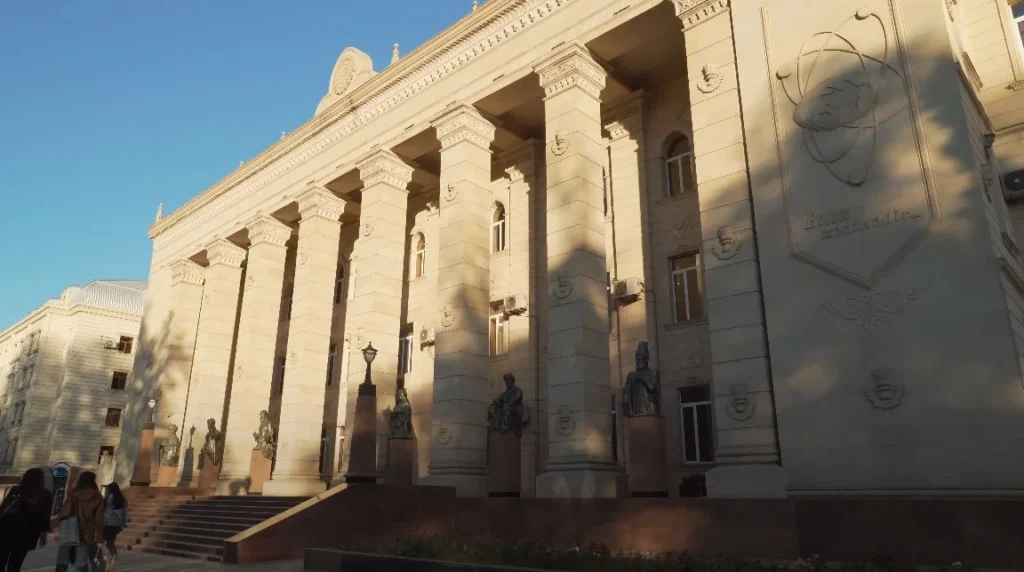
This building stopped me mid-walk. The late afternoon light was hitting it just right – all those white columns glowing against the blue sky. Turned out it was the National Academic Opera and Ballet Theater. I didn’t go inside (no performances while I was there), but I circled it twice just looking at the details.
Classical European facade but with these subtle Islamic geometric patterns worked into the decorative elements. That’s Baku in a nutshell – layers of influence that somehow work together instead of fighting each other.
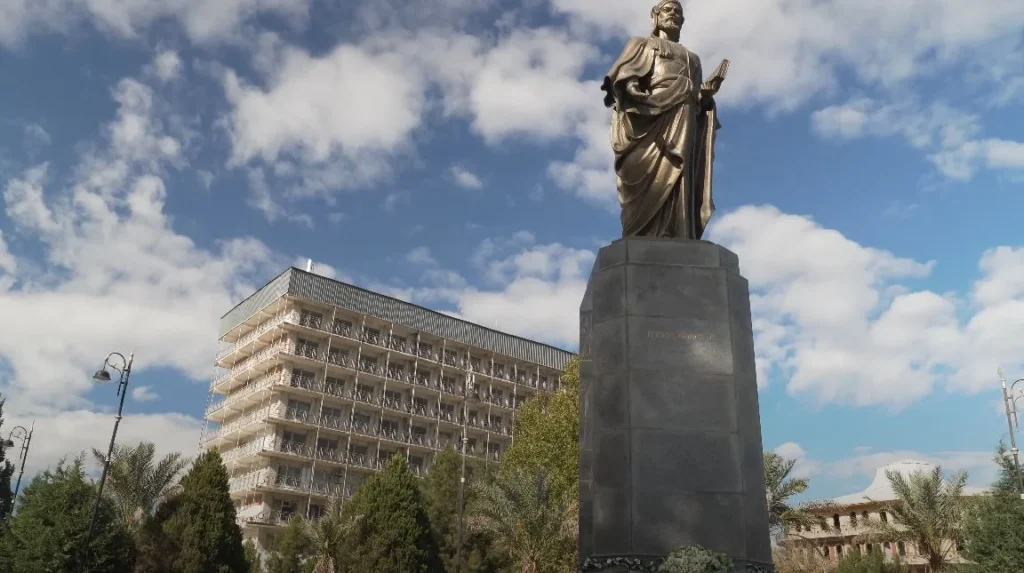
Monuments everywhere. This particular one – some classical figure in flowing robes – stood in a traffic circle near my hotel. Nobody seemed to notice it much, which I found oddly perfect. History as furniture.
The parks were packed with families in the evenings.
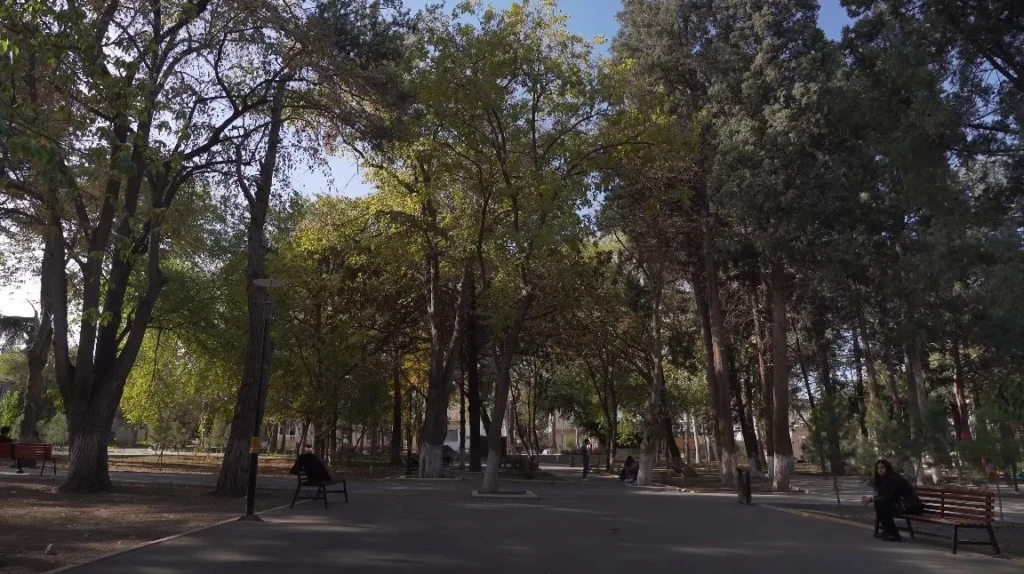
These wide paths under massive trees. Old couples on benches. Kids on scooters. The whole scene felt timeless – could’ve been 1985 or 2025, hard to tell.
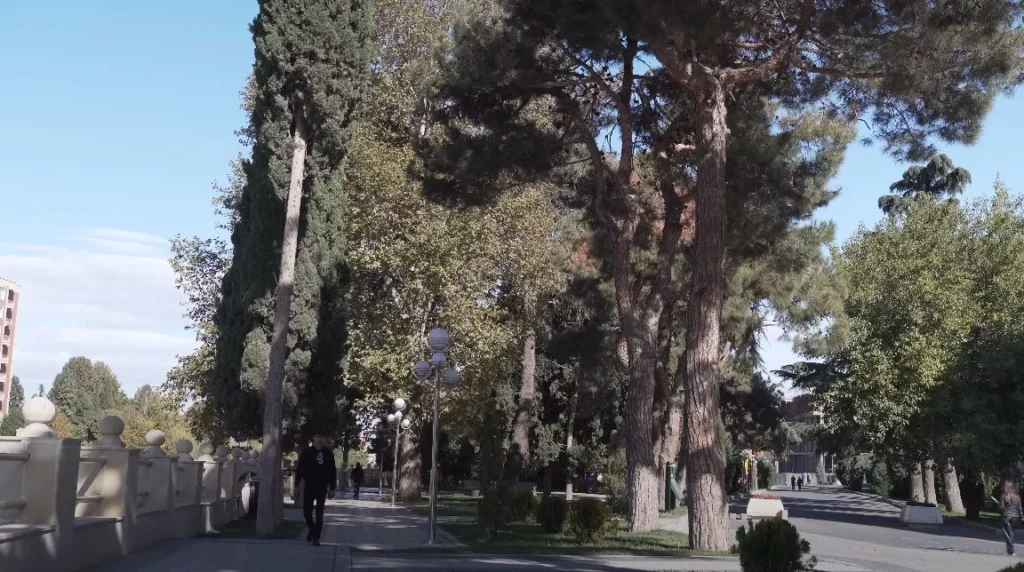
Diving Into History
The Old City Pulls You In
Icherisheher – the walled Old City – doesn’t announce itself. You’re just suddenly walking on older stones and the buildings lean in closer and the tourist groups appear with their flag-following guides. But if you duck down a side alley, you can lose them completely.
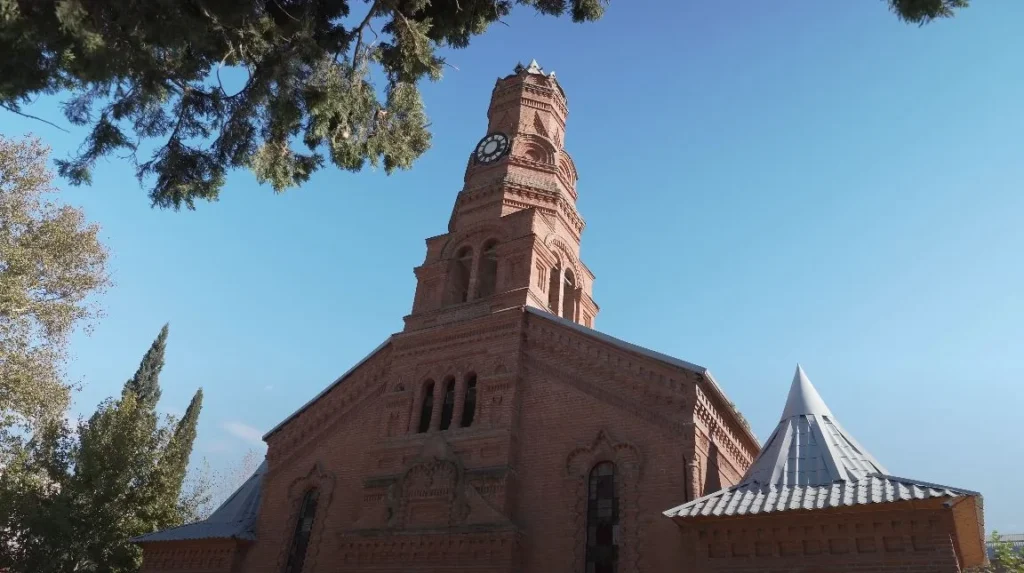
Found this Lutheran church tucked away. Red brick, German-built during the oil boom of the 1800s when Baku had this weird international community of oil barons and engineers. The clock tower was still running. I watched it for three minutes just to confirm – yep, actually telling time.
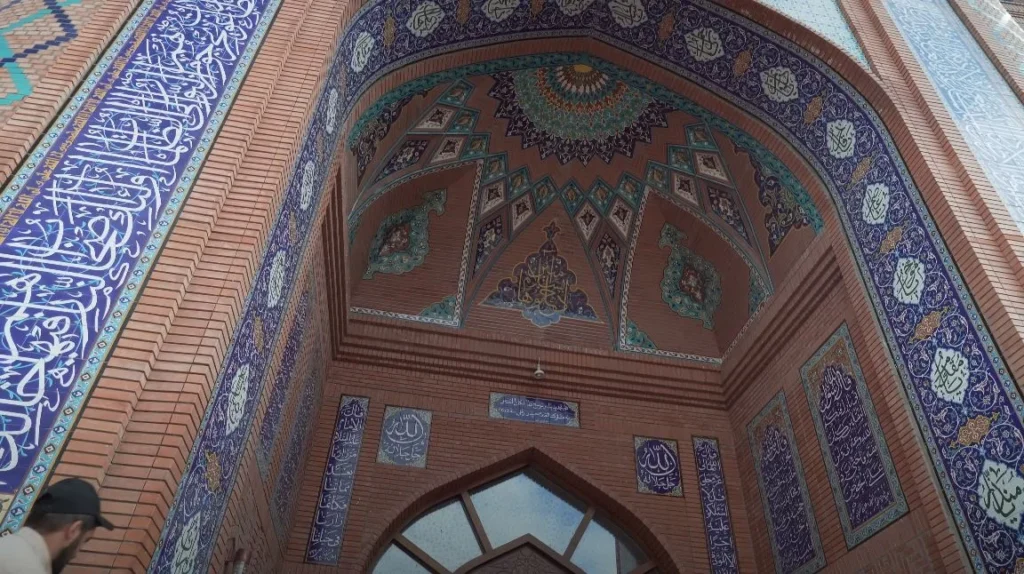
The mosques were quieter than I expected. Maybe because I visited mid-morning when it wasn’t prayer time. This particular one had tilework that made me stop breathing for a second. Blues and golds and geometric patterns so precise they looked computer-generated. But no – hand-placed, centuries ago. I tried to photograph it and immediately realized my phone camera was insulting the craftsmanship.
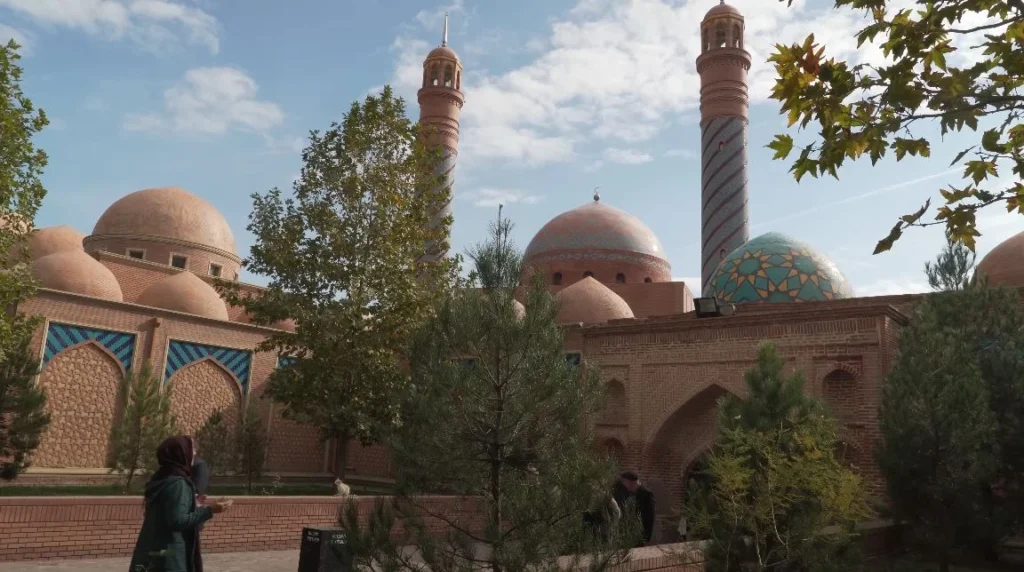
Some mosques let you wander if you dress modestly and take off your shoes. Others had caretakers who’d wave you away politely. I respected that. These weren’t museums – people actually used these spaces.
The Caravanserai: Where Silk Road Traders Slept
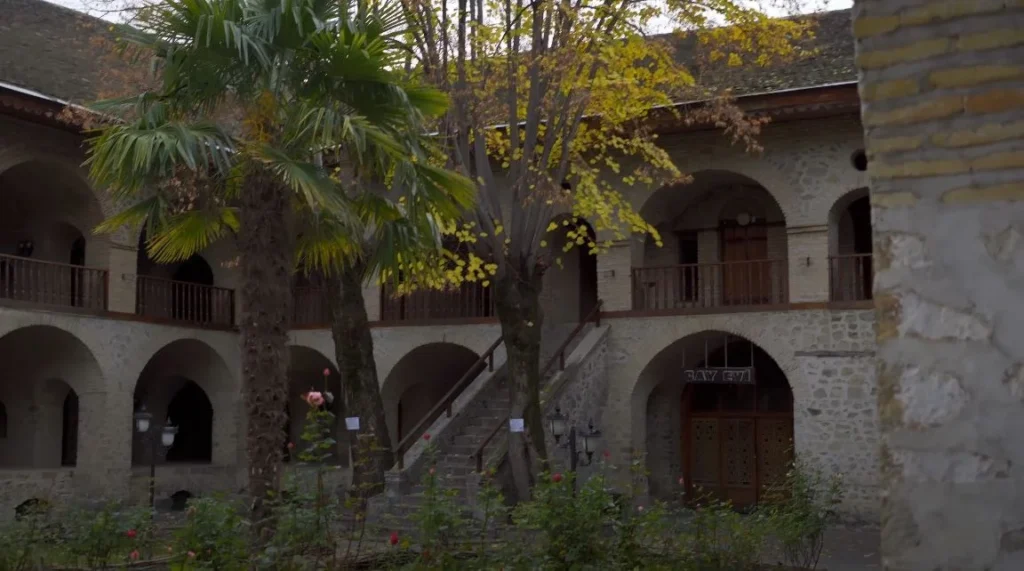
This was the moment I understood why people obsess over the Silk Road. The caravanserai – basically a medieval roadside inn – was this perfect square of stone arches surrounding a courtyard. You could picture it: merchants unloading camels, negotiating deals in six languages, sleeping in those small rooms that circled the upper level.
The stone was worn smooth in places where centuries of footsteps had landed in exactly the same spots. Palm trees grew in the center now, which felt anachronistic but somehow right. A rose garden bloomed near the entrance. The whole place smelled like history and flowers.
I sat on the steps for an hour. A tour group came through, took photos, left. Then it was just me and an older couple who seemed to be having some kind of disagreement about which arch led where. Eventually they left too.
Silence in a caravanserai feels different. Heavier. Like the walls remember the noise.
When the Landscape Gets Biblical
Someone at my hotel mentioned Qobustan. “You have to go,” she said. “It’s not far.”
She was right about it not being far – about an hour south. She was wrong about it being a simple day trip. Qobustan was the kind of place that rewires your sense of time.
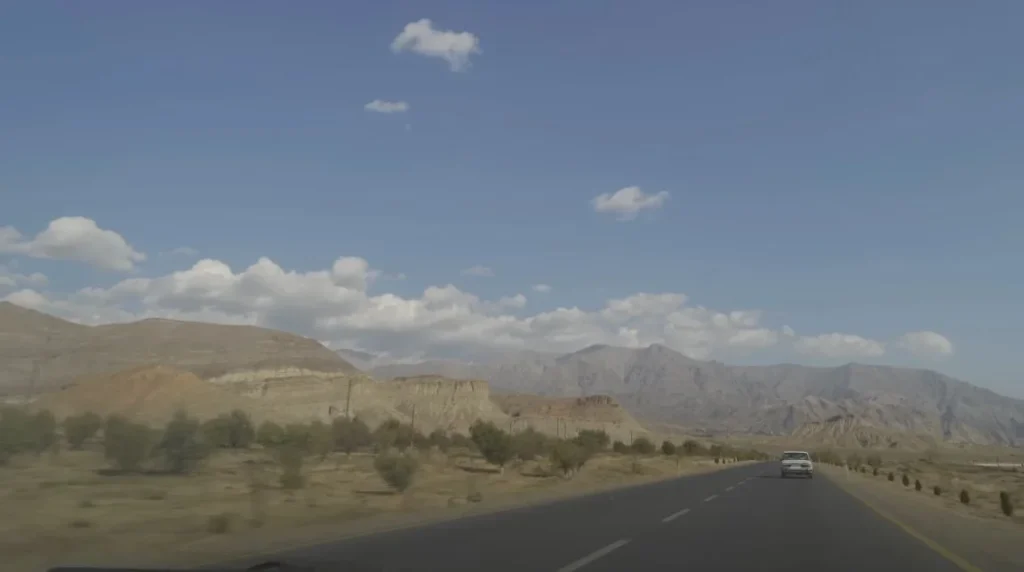
The drive itself was already doing things to my brain. The highway cut through this landscape that looked lunar – all beige and grey and these massive geological formations that I couldn’t make sense of. Mountains, but not like normal mountains. More like the earth had been squeezed and folded and then left to bake in the sun for a few million years.
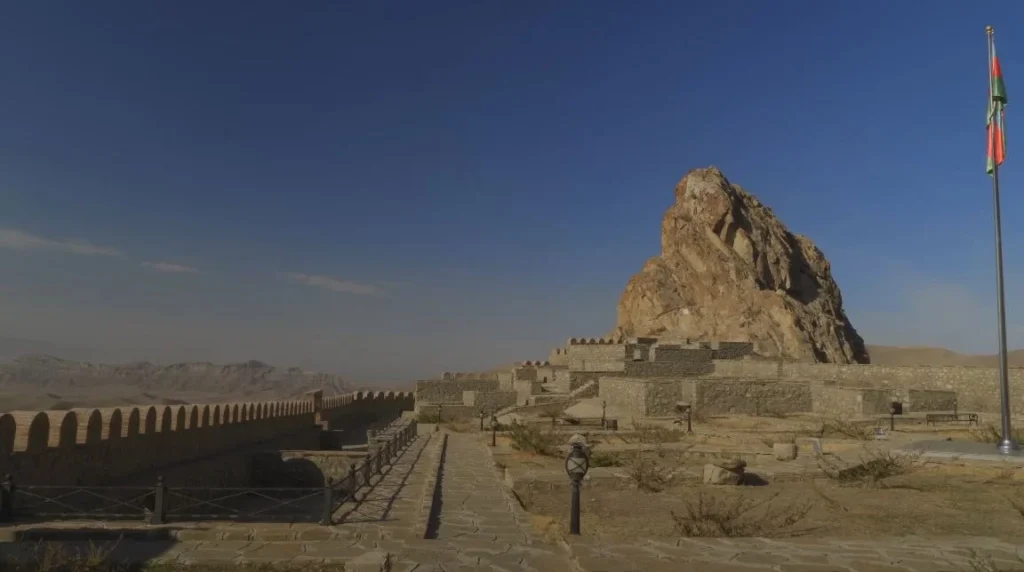
Then this fortress appeared, built right against this massive rock outcropping. The rock itself looked like it had been carved by wind and time into something that belonged in a sci-fi film. The fortress walls – mud brick, ancient – seemed almost incidental next to the natural drama of the stone.
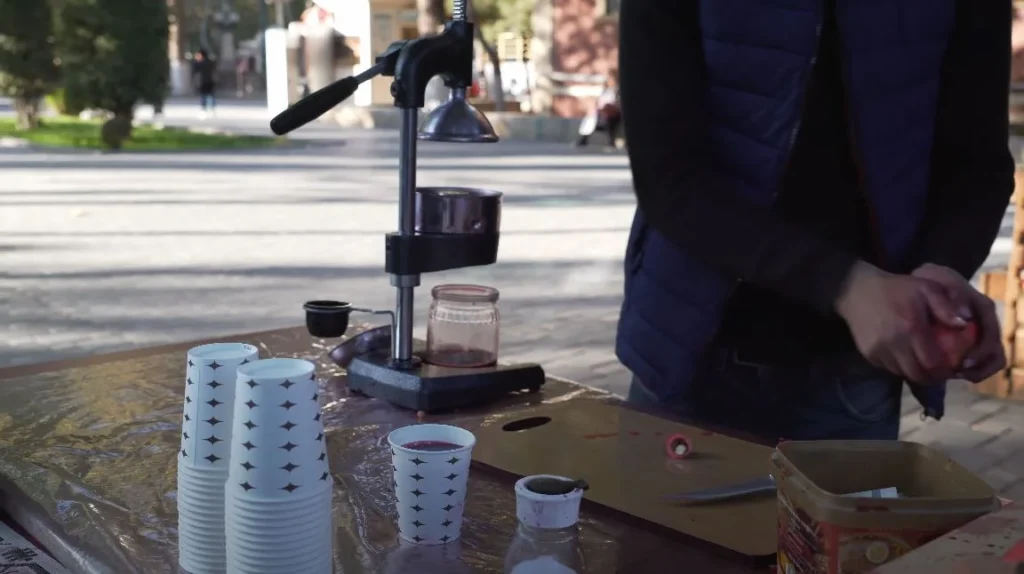
I walked out into the landscape around sunset. Bad idea in terms of timing (the site was about to close), great idea in terms of atmosphere. The mountains went from beige to purple to almost black as the light dropped. The wind picked up. I was completely alone out there for maybe fifteen minutes.
That kind of solitude does something. Makes you realize how small you are. How temporary.
Museums and Cultural Spaces
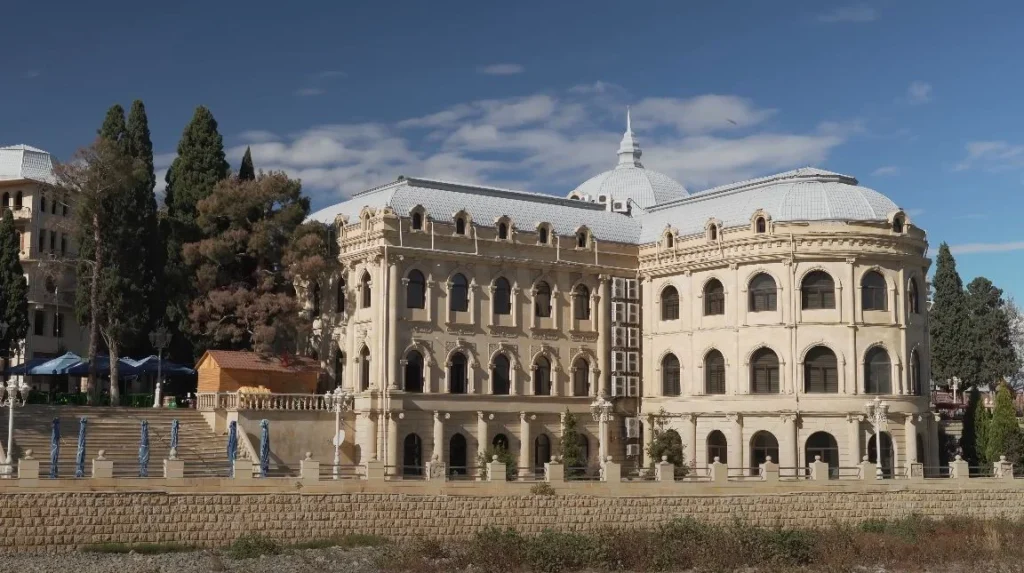
Back in Baku, I spent an afternoon hitting the museum circuit. This building – all domes and spires and that cream-colored stone – housed one of the cultural centers. I’m being vague because honestly, I wandered into several buildings without really confirming what they were. My navigation strategy was “that looks interesting” followed by “oh, there’s a door.”
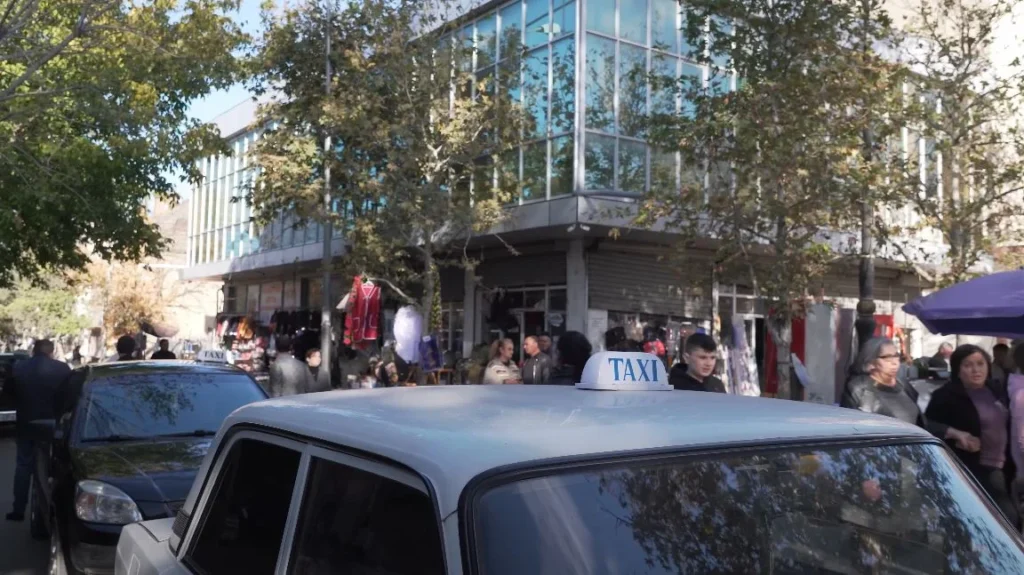
Some of these places were clearly government-adjacent. Very official. Very “please don’t touch anything.” Others were more relaxed. I found a small exhibition on Azerbaijani carpet weaving in one basement that had maybe three other visitors the whole time I was there.
The carpets, though. They deserved a crowd.
The Food That Stops Conversations
Learning to Eat Like a Local
You can’t understand Azerbaijan without understanding it’s relationship with food. Not just the dishes themselves – though we’ll get there – but the whole ritual around eating. The way meals stretch for hours. The way “just tea” turns into a full spread.
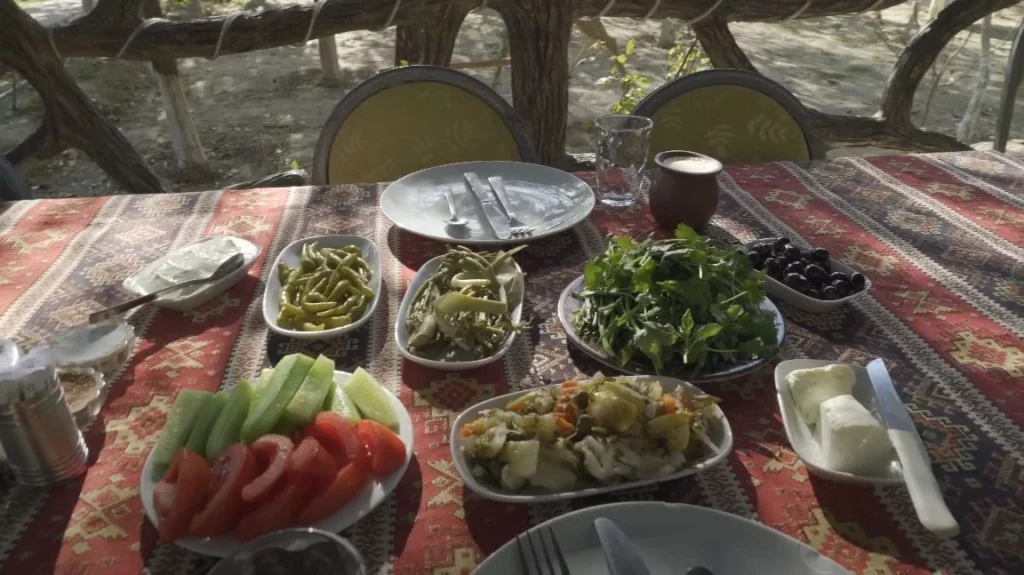
This meal happened my third day. I’d been invited to join a local family for lunch – one of those random connections you make when you’re traveling alone and looking lost. I met the father near the markets, asked him where to buy good spices and somehow thirty minutes later I was in his car heading to his village home outside the city.
The table was set under trees. You can see it – pickled everything, fresh vegetables cut thick, that pile of greens in the center, olives the size of grapes. The cheese was local, the bread was from that morning. Everything tasted like it had a story.
We sat there for three hours. Maybe four. Time stopped being relevant somewhere between the second and third pot of tea.
Breakfast That Became an Obsession
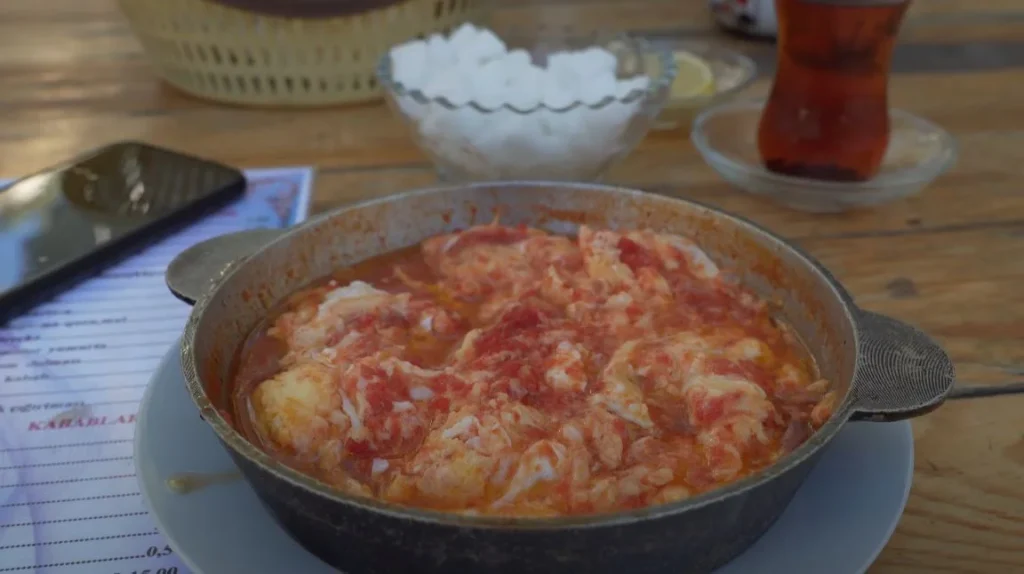
This dish changed my mornings. Tomato-based eggs cooked in a traditional cast iron pan – they call it “tomato-yumurta” and it’s everywhere for breakfast. Simple concept: eggs, tomatoes, peppers, butter, salt. But something about the way they cook it – high heat, quick, served bubbling hot in that same pan – makes it completely different from anything I’d tried before.
I ordered it four days in a row from four different places. Each slightly different. One place added herbs I couldn’t identify. Another made it spicier. The tea came in those small pear-shaped glasses, always too hot to hold properly, always perfect.
The sugar cubes on the side weren’t for the tea directly – you’re supposed to hold one between your teeth and sip the tea through it. I felt ridiculous doing it the first time. By day three I was a convert.
Markets and Street Food Reality
The markets were overwhelming. Not in a bad way, but in that way where your senses get so flooded you have to just stop and recalibrate.
Pomegranates everywhere. Mountains of them. The vendors would crack one open to show you how red the seeds were inside – the deeper the red, the sweeter. I bought three and immediately regretted it because I had nowhere to actually eat them except standing on the street corner like some kind of fruit-obsessed tourist.
Which is exactly what I did.
The herbs came in bundles bigger than my head. Dill, cilantro, parsley, things I didn’t recognize. Old women sat behind their displays looking unimpressed by everything. When you picked something, they’d weigh it on these ancient scales with actual weights – no digital anything.
I watched one woman argue with a vendor for seven minutes over what seemed like 20 qəpik. About 12 cents. The principle mattered more than the money.
Street tea vendors became my unofficial tour guides. They knew everything. Which bus goes where. What time the museums actually close (not the posted time, the real time). Where to find good baklava. One guy told me about a place serving plov – Azerbaijani rice pilaf – that wasn’t in any guidebook I’d seen.
I went. He was right.
Religion and Daily Rhythm
The Call to Prayer as City Soundtrack
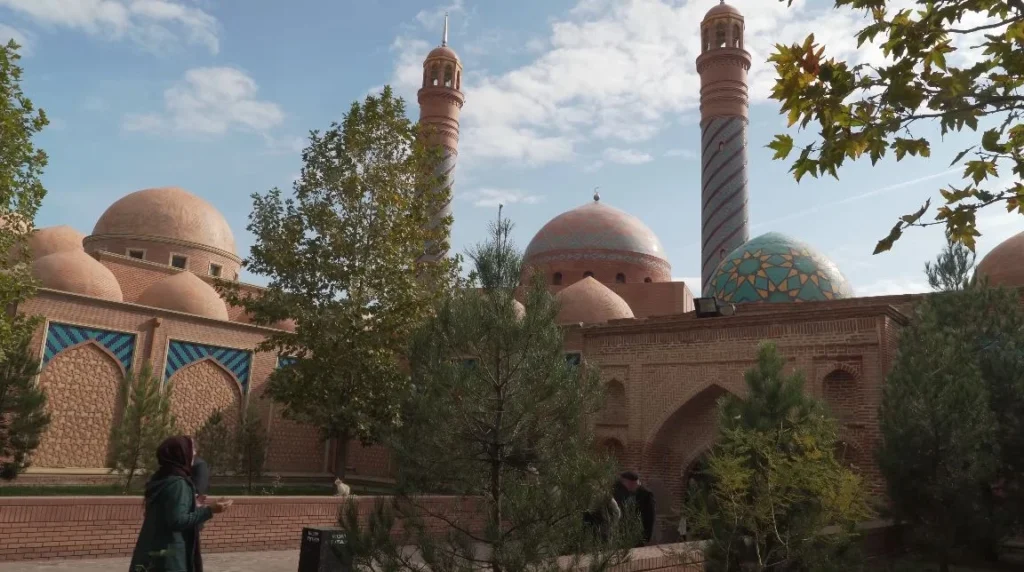
Five times a day, the adhān would echo across the city. Call to prayer from multiple mosques at slightly different times, creating this layered soundscape. In the Old City especially, you couldn’t escape it. Not that I wanted to.
I’m not Muslim, but there’s something about hearing that call that makes you stop what you’re doing. It punctuates the day. Dawn, midday, afternoon, sunset, night. The city organized itself around these moments even if people didn’t actually go to pray.
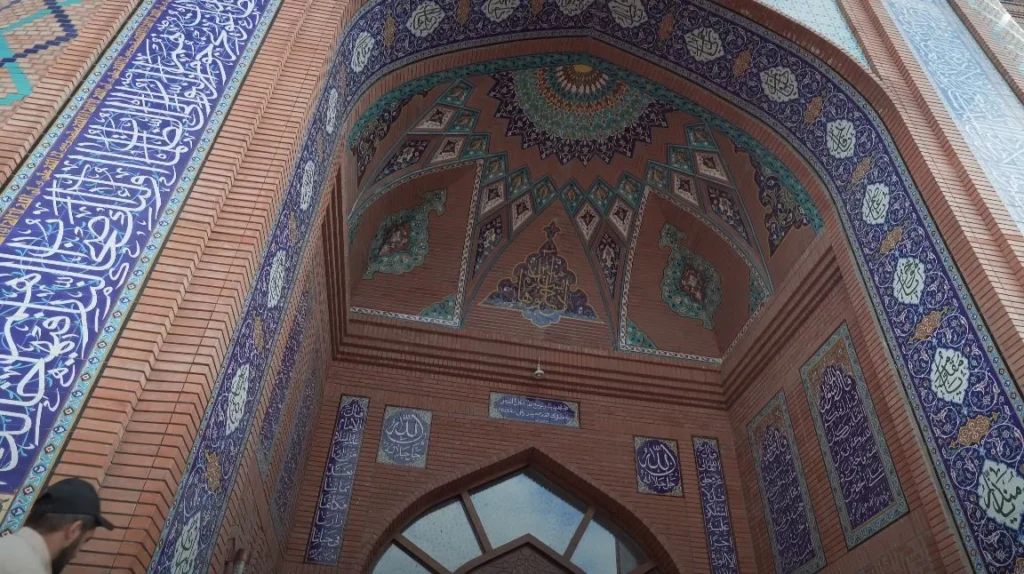
Inside the mosques – the ones that let me wander – the silence between prayers felt sacred in a way I don’t have better words for. People came in to sit. Not to pray, necessarily. Just to sit in that particular kind of quiet that religious spaces hold.
I did that a few times. Took off my shoes, found a spot against the wall, just sat. Watched light move across those impossible tile patterns. Listened to the building breathe.
Churches That Survived Everything
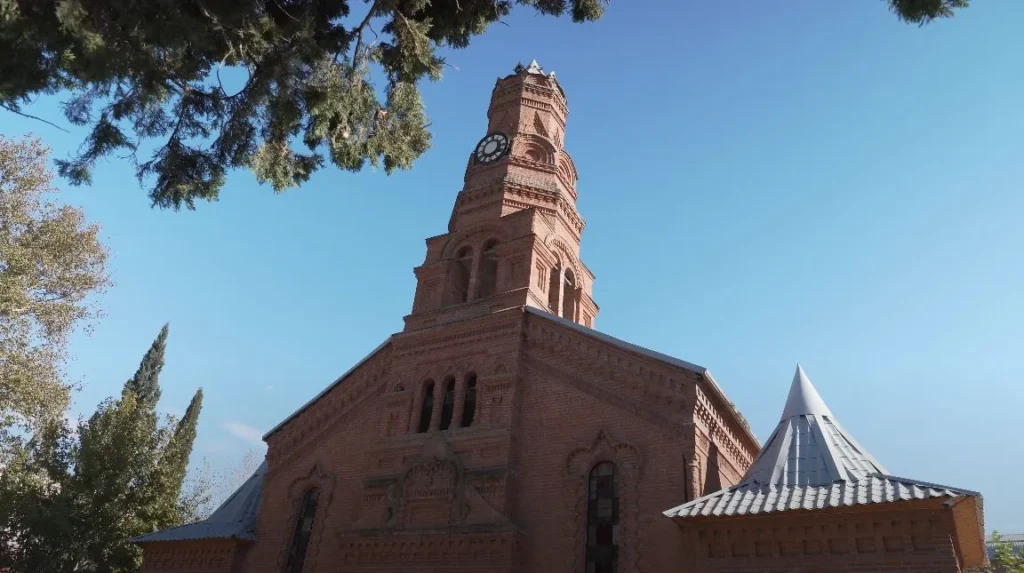
The Lutheran church was locked when I first found it, but I came back the next day and an old man was opening the heavy wooden doors. I asked in bad Russian if I could look inside. He nodded, said nothing, disappeared.
The interior was simpler than the mosques. Wood pews, plain walls, a few stained glass windows that looked like they’d been replaced recently. But that clock tower – you could climb it for 2 manat. The stairs were steep and narrow and definitely not up to any modern safety code.
The view from the top was worth every sketchy moment.
You could see the whole Old City from up there. The flat roofs, the narrow streets, the Maiden Tower in the distance. The Caspian beyond. I stayed up there until the old man rang a bell – not a church bell, just a hand bell – signaling I needed to come down.
Road Trips Into the Strange
Driving Through Geological Time
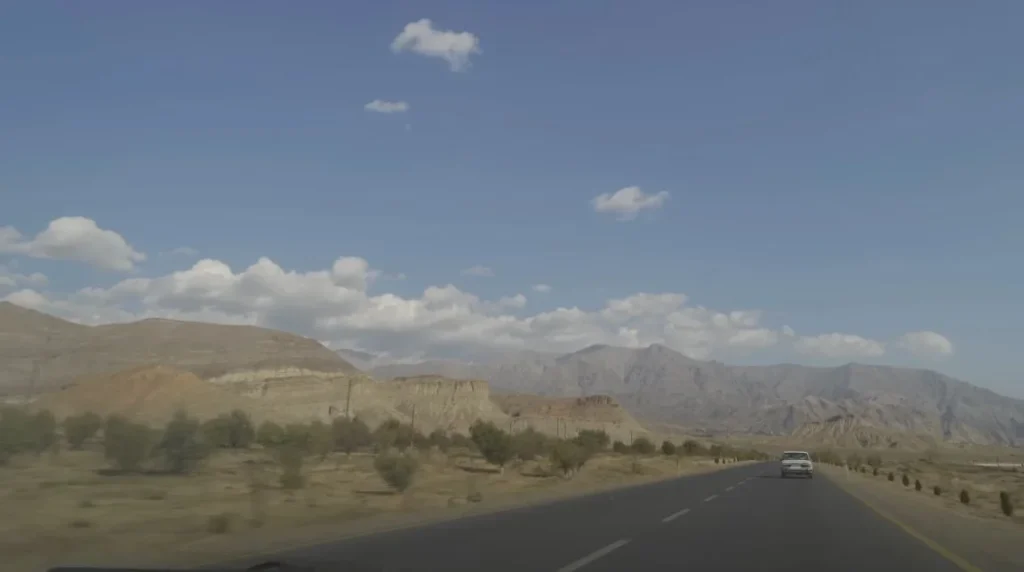
Rented a car for two days. Probably stupid given Baku traffic, but I wanted to see the countryside without waiting for buses.
The driving was… chaotic but manageable. Lane markers seemed more like suggestions. Speed limits were theoretical. But everyone had this flow – if you committed to a merge, people let you in. If you hesitated, you’d sit there forever.
Got out of the city and the landscape opened up into these vast brown expanses. Mountains that looked like crumpled paper. Almost no vegetation once you got past the Caspian coast. Just rock and sky and this highway that someone had decided to build through terrain that clearly didn’t want a highway.
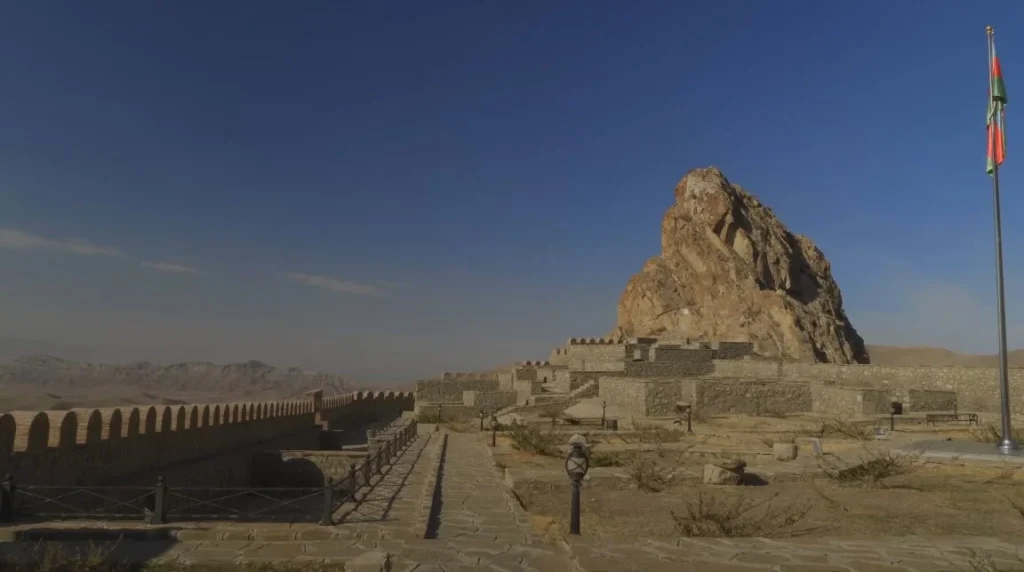
Places like this fortress just appeared. No signs, no context, just suddenly: ancient wall, massive rock, history sitting there in the sun. I pulled over, climbed up to the fortress entrance. The door was locked but the walls were low enough to look over.
The rock formation behind it looked like it had been placed by aliens. Too geometric to be natural, too massive to be man-made. Later I learned these were mud volcanoes – dormant now, but millions of years ago they were active. The whole region is geologically unstable, which explains why everything looks vaguely apocalyptic.
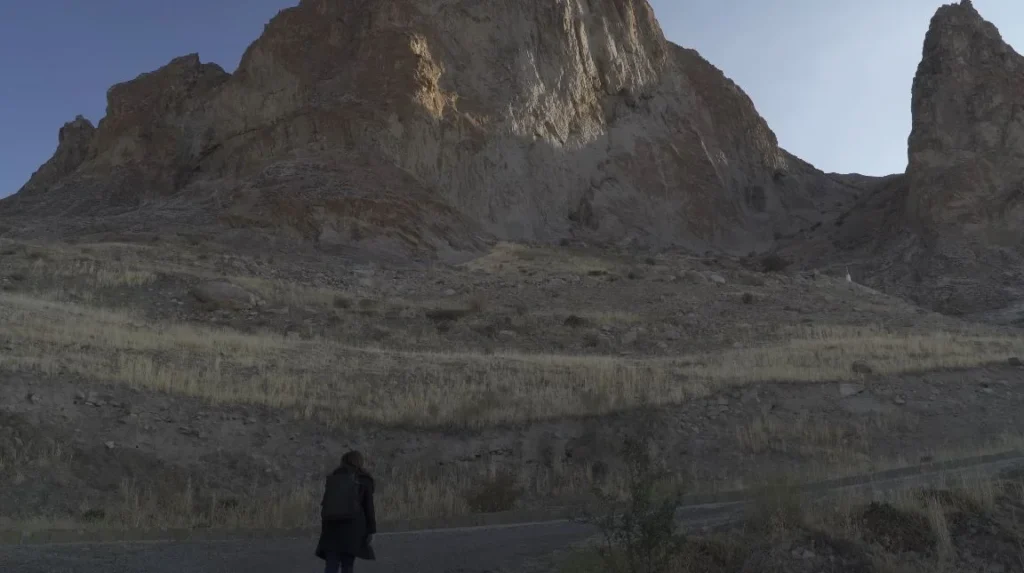
Got out of the car at one point and just walked into the landscape. No path, no destination. The ground was crusty, cracked in places. The mountains in the distance looked closer than they were – that trick deserts play with perspective.
The silence was complete. No birds, no wind, no other humans. Just the sound of my boots on the dry earth and this overwhelming sense that I was very, very far from anything familiar.
I stood there until the sun started dropping and the temperature followed. Then got back in the car and drove back toward civilization, feeling like I’d touched something old.
Villages That Time Forgot
Passed through several small villages on the way back. Most were just clusters of houses, maybe a shop, a mosque. People stared at the rental car – not hostile, just curious. Foreign plates, lost tourist, what’s the story?
Stopped at one place to ask for directions. Ended up invited into someone’s home for tea. Again. This kept happening. Azerbaijani hospitality is aggressive in the best possible way.
The house was simple. Concrete walls, rugs everywhere, a TV playing some Turkish drama. The family – three generations in one room – watched me try to explain where I was trying to go using Google Maps on my phone. Eventually the grandfather just pointed. “That way. Twenty minutes.”
He was right. It took forty minutes, but he was directionally correct.
The Details That Stick
Public Transport as Performance Art
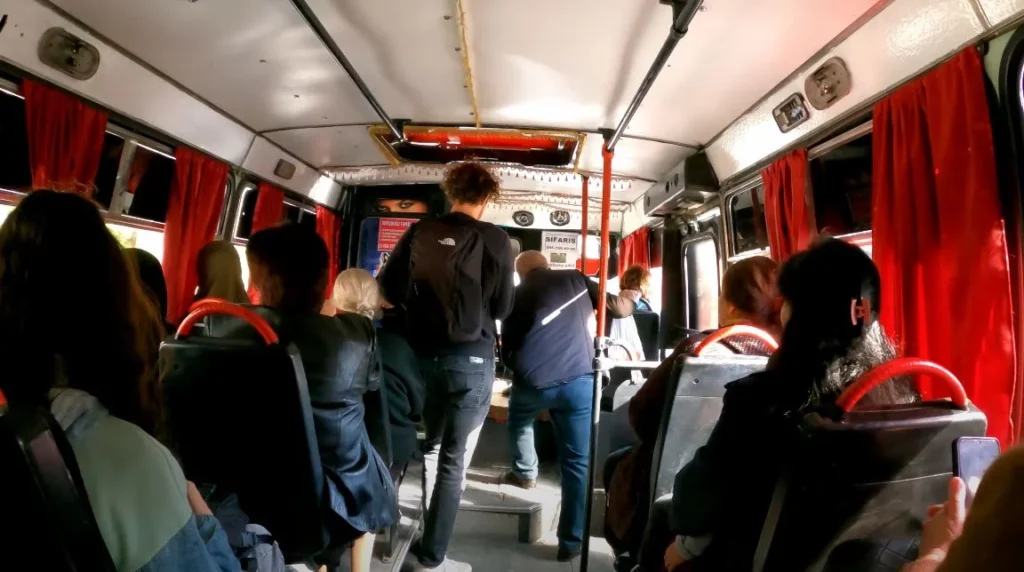
I keep coming back to that bus. Those red curtains. The way the driver had arranged his life around the steering wheel – photos, religious icons, a air freshener shaped like a rose. The way people squeezed in beyond all logic and somehow it worked.
There’s something about public transport in former Soviet republics that feels different. It’s not just getting from point A to point B. It’s a social space. People talk. They help each other. An old woman got on with too many bags and three different people grabbed them without being asked.
Metro was cleaner, more efficient, but less interesting. Soviet-built, deep underground, those escalators that go down forever. The stations had this brutalist beauty – all concrete and geometric patterns. But sterile. The buses had life.
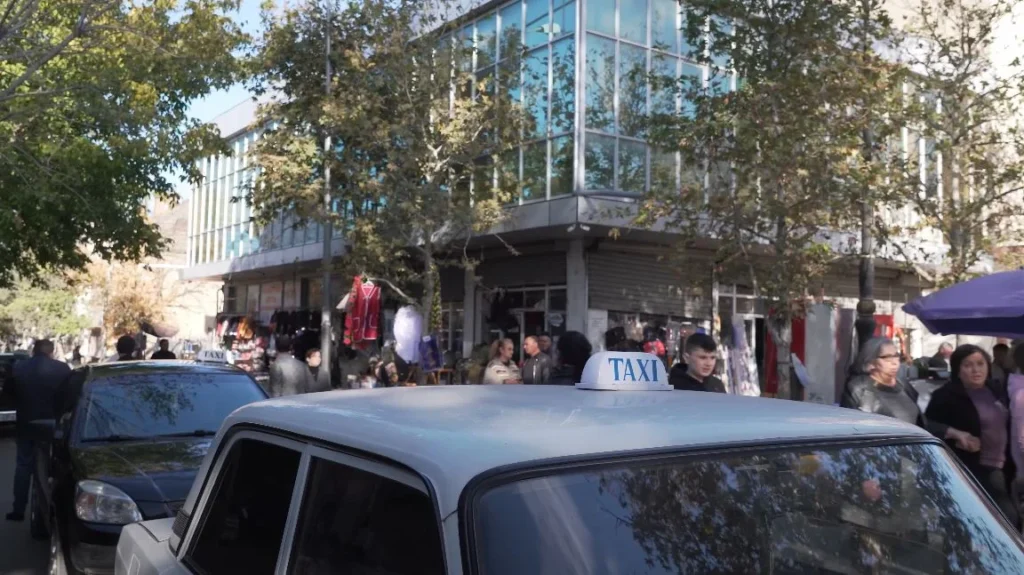
The Vintage Car Situation
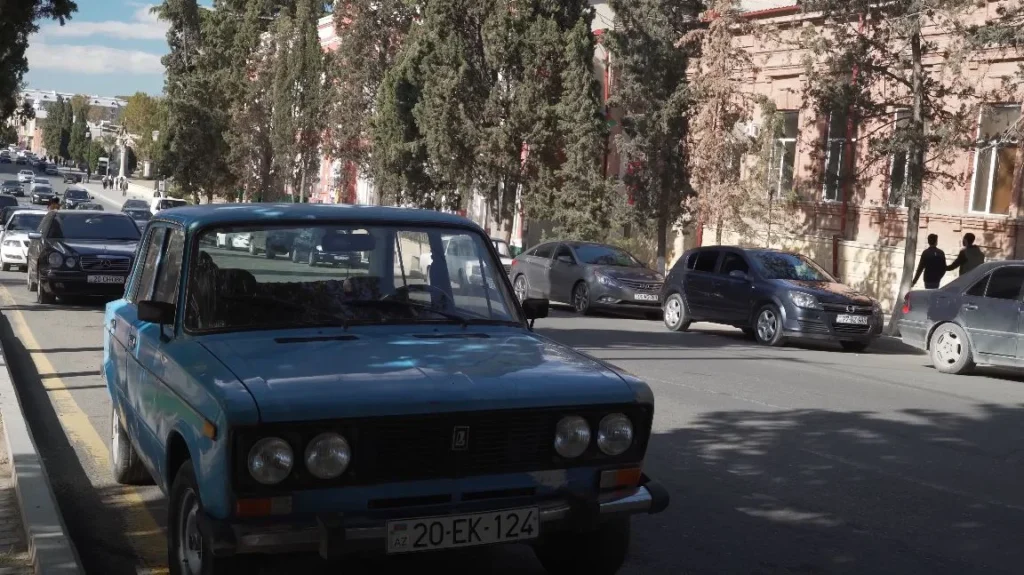
This Lada. License plate from what, 1999? 2001? Still running. Parked like it belonged there, which it absolutely did.
Baku has this split personality with cars. New money drives German luxury. Everyone else drives Soviet holdouts kept alive through mechanical prayer and replacement parts scavenged from other dead Ladas.
I saw one guy with the hood open, engine running, adjusting something with a wrench while his friend held a flashlight in broad daylight. They weren’t fixing a problem – they were just tweaking. Constant maintenance as a way of life.
Street Scenes and Random Encounters
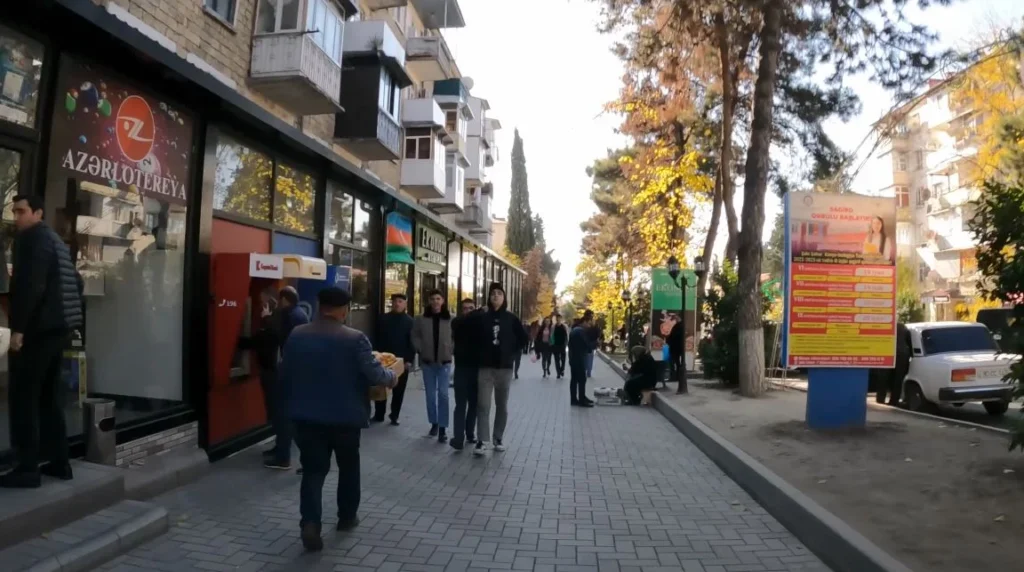
Walking became my default mode. Baku is a walking city if you ignore the traffic. Pedestrian streets like this one – the sign says “Azərbaycan” something – were packed every evening. Window shopping, meeting friends, just existing in public space.
I watched people. That’s what you do when you travel alone and don’t speak the language. You watch.
Couples holding hands but looking at their phones. Groups of teenage boys trying to look tough and failing. Women dressed impossibly well for just walking around. Old men sitting on benches judging everyone.
Same as everywhere, but different. The rhythm was different. Slower in some ways, more intense in others.
Departure Day Thoughts
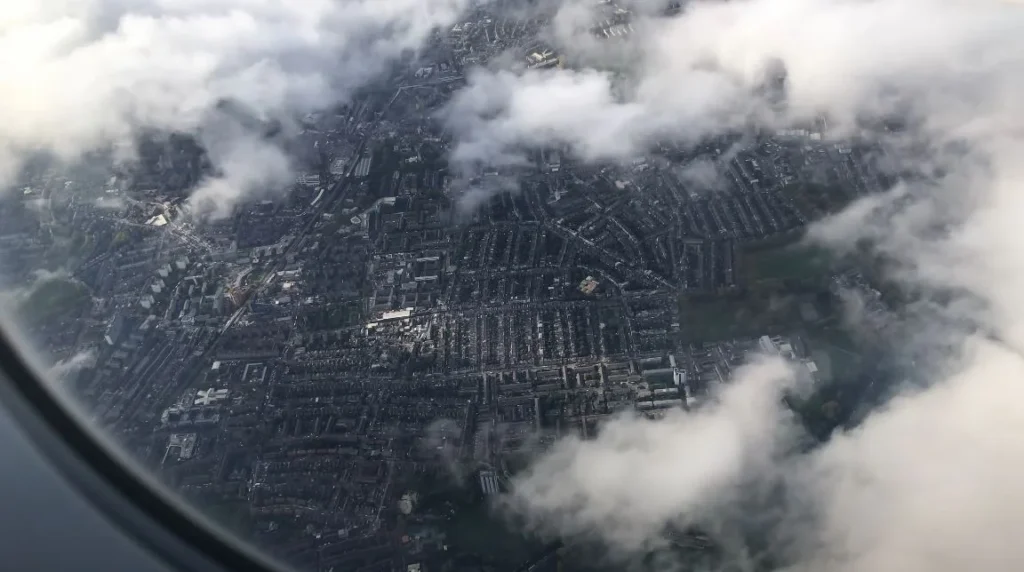
My last morning I woke up early, checked out, sat in a café near the hotel drinking one more tea with one more sugar cube held between my teeth.
The flight was at noon. I should’ve headed to the airport but I wandered instead. One more loop through the Old City, one more look at the Caspian, one more attempt to memorize the way the light hit those golden trees.
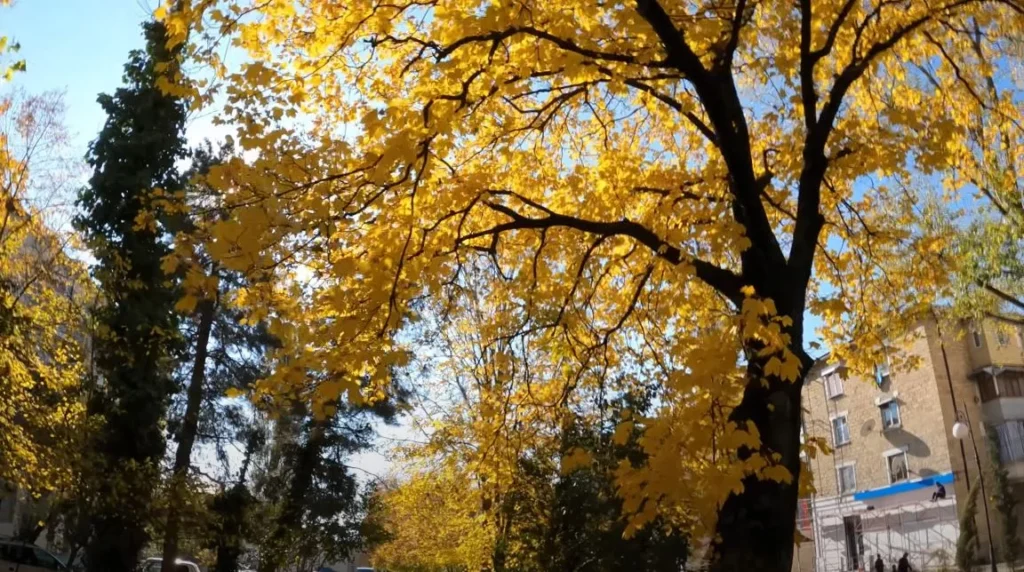
Azerbaijan surprised me. That’s the best way to put it. I came with zero expectations – which helped – but left with this sense that I’d seen something real. Not the tourist version of a place, though I definitely did touristy things. But something underneath that.
The way the street tea guy started recognizing me.
The random invitations into people’s homes.
The ancient caravanserai sitting empty except for me and some roses.
That Lada still running.
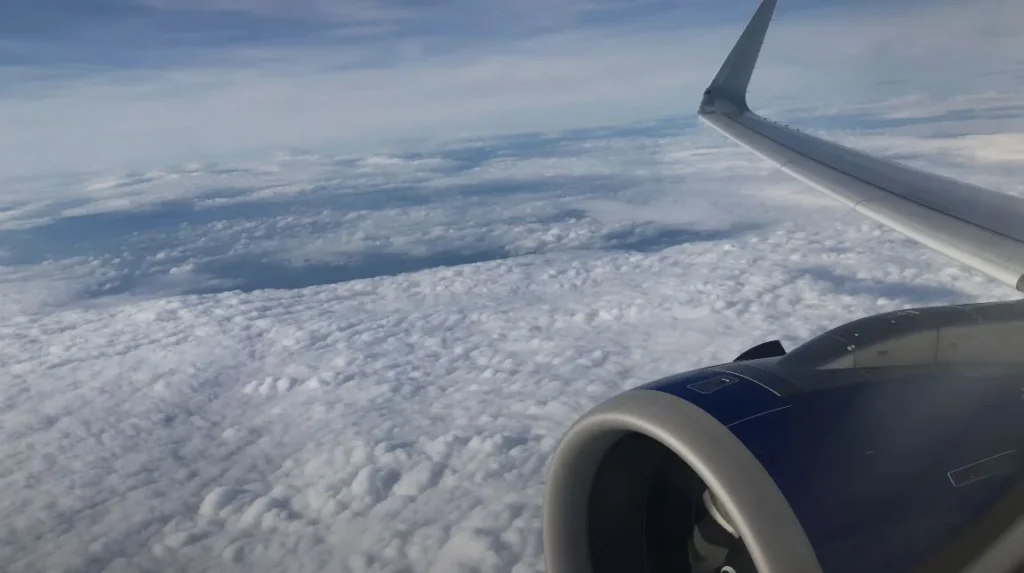
The plane lifted off and Baku got smaller. The Flame Towers caught the sun, those Caspian waves became texture, the mountains faded into haze.
I had pomegranate seeds in my bag. Bought them that morning even though I knew they’d get confiscated at security. They did. But for two hours I had pockets full of Azerbaijan and that seemed important somehow.
What I Learned (Or Think I Did)
Some scattered thoughts for anyone planning this trip:
On timing: October was perfect. Not too hot, not yet cold. Autumn colors everywhere. Tourist crowds manageable. Summer would be brutal, winter would be grey.
On money: Cash is king. Cards work in major places but bring cash. The manat is stable enough. ATMs are everywhere in Baku, less so outside.
On language: Russian helps more than English outside hotels. Azerbaijan language is Turkic – if you speak Turkish you’re golden. I spoke none of these and survived, but learn “salam,” “sagol,” and numbers. People appreciate the effort.
On transport: Metro is cheap and efficient. Buses are chaos but fun. Taxis are negotiable. Renting a car is doable but know what you’re getting into with the traffic.
On food: Just eat everything. Street food is safe. Markets are where locals eat. Tourist places are fine but unnecessary. Tea is always free after a meal if you ask.
On people: Friendlier than expected. Almost aggressively hospitable. If someone invites you somewhere, say yes. That’s where the real trip happens.
On pace: Slow down. Baku can be done in a day if you rush, but why would you? Spend time sitting in parks. Walk the Old City multiple times. Get lost. Azerbaijan rewards aimless wandering.
Final Thoughts From the Road
I think about that park a lot now. Those benches, those trees, those families just being families. Nothing dramatic happened there. I sat, watched the light change, left.
But that’s the thing about travel sometimes. The moments you remember aren’t the big monuments or famous sites – though those matter too. It’s the quiet spaces between. The tea vendor who remembered how you take your sugar. The old man in the church who let you climb the tower. The family that fed you lunch for no reason except you seemed hungry.

